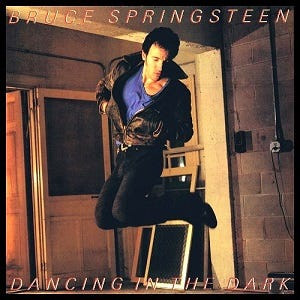Bruce Springsteen’s “Dancing in the Dark” is more than just an iconic 80s hit; it’s a profound exploration of youthful yearning, capturing the universal desire for hope, purpose, and human connection. Released in 1984 as part of the album Born in the U.S.A., this song, often abbreviated as DITD, encapsulates the distress and aspirations of a generation within its concise four-minute runtime. While seemingly upbeat and danceable, “Dancing in the Dark” delves into the complexities of loneliness, the search for meaning, and the tentative hope for change.
The 1980s Soundscape of Yearning
The song opens with a distinctive keyboard riff, immediately setting a tone that might, by contemporary standards, feel slightly dated. This isn’t the hyper-produced sound of modern pop, but rather a sound reminiscent of a bygone era, evoking a sense of nostalgic yearning. The saxophone solo that punctuates the song further enhances this atmosphere, creating a sonic landscape that is both familiar and melancholic. The steady, matter-of-fact drumbeat and moderate tempo contribute to a feeling of brisk introspection, as if Springsteen is taking a walk alongside the listener, sharing his worries and acknowledging their shared experiences. This musical arrangement, while seemingly simple, is crucial in conveying the song’s underlying emotional weight. It’s neither overly celebratory nor deeply sorrowful, but resides in a poignant in-between space, mirroring the complex emotions of its lyrics.
Beyond the Surface: Lyrical Depth in Dancing in the Dark
Initially, “Dancing in the Dark” might be perceived as a straightforward song about romantic frustration or the desire for physical intimacy. Indeed, the lyrics touch upon these themes, reflecting a youthful “thirst” for connection. However, to interpret the song solely on this surface level is to overlook its deeper exploration of codependency and existential loneliness. The yearning for physical closeness is presented not just as mere lust, but as an extension of a more profound need for human connection and understanding. As Springsteen sings, “I get up in the evening and I ain’t got nothing to say,” he articulates a sense of daily monotony and emotional stagnation. Each day blurs into the next, devoid of meaning or distinguishing events. This feeling of being trapped in a cycle of sameness fuels the desire for something – or someone – to break through the darkness.
 Bruce Springsteen performing Dancing in the Dark on stage, capturing his energetic stage presence
Bruce Springsteen performing Dancing in the Dark on stage, capturing his energetic stage presence
A Hustler’s Anthem with a Vulnerable Heart
Another interpretation of “Dancing in the Dark” positions it as a hustler’s anthem, with the protagonist projecting an image of confidence and offering an escape. The line “You can’t start a fire without a spark” suggests a need for action and change, a rejection of passivity. The “gun for hire” metaphor implies a willingness to do whatever it takes to break free from the current situation, offering a sense of liberation, even if temporary. However, beneath this veneer of self-assuredness lies a vulnerability. The protagonist is not simply a confident operator; he is someone who needs connection and validation just like anyone else, perhaps even more so. His willingness to “put the laugh on me” and his plea for a “love reaction” reveal a deeper insecurity and a genuine need for reciprocation. He is not just offering escape; he is also seeking it.
The Healing Power of Dancing in the Dark
Ultimately, “Dancing in the Dark” is about the search for respite and the transformative power of human interaction. Springsteen acknowledges the woman’s worries and sadness, recognizing her “little world falling apart.” His invitation to dance, even “just dancing in the dark,” is an offer of temporary oblivion, a chance to forget burdens and find solace in movement and shared experience. This “respite,” as Springsteen suggests, is something universally sought after, especially by young people navigating the complexities of life. Whether through music, dance, or human connection, the desire to escape the confines of self and find a moment of shared joy or understanding is a fundamental human need. “Dancing in the Dark” captures this yearning perfectly, offering not just a catchy tune, but a resonant exploration of hope and connection in the face of personal struggles.
In conclusion, “Dancing in the Dark” transcends its status as a chart-topping single. It’s a nuanced portrayal of youthful longing, exploring themes of loneliness, the desire for connection, and the persistent search for hope. Through its evocative lyrics and 1980s soundscape, the song continues to resonate with audiences, reminding us of the universal need to find light and connection, even when we feel like we’re just dancing in the dark.

